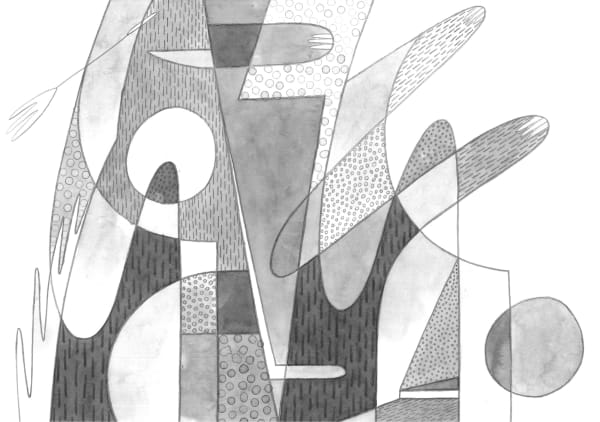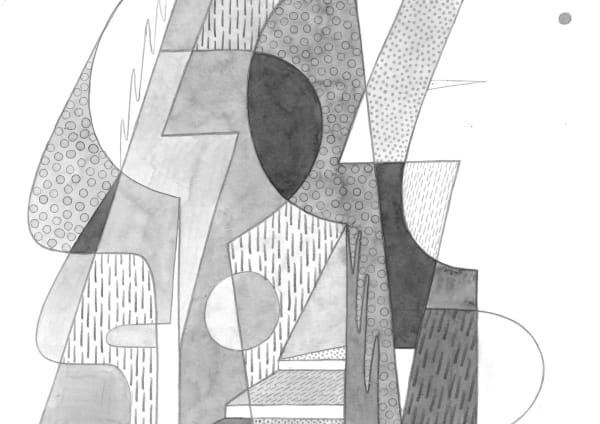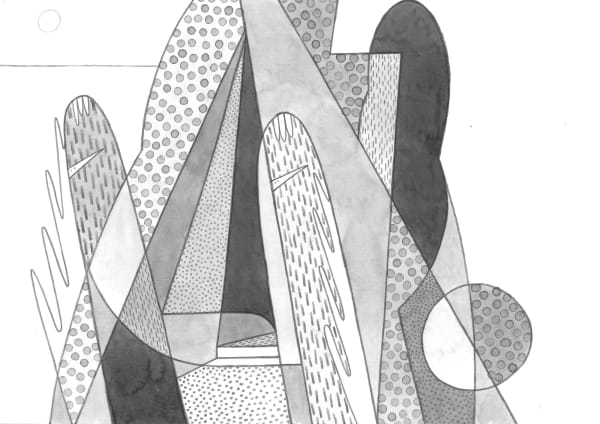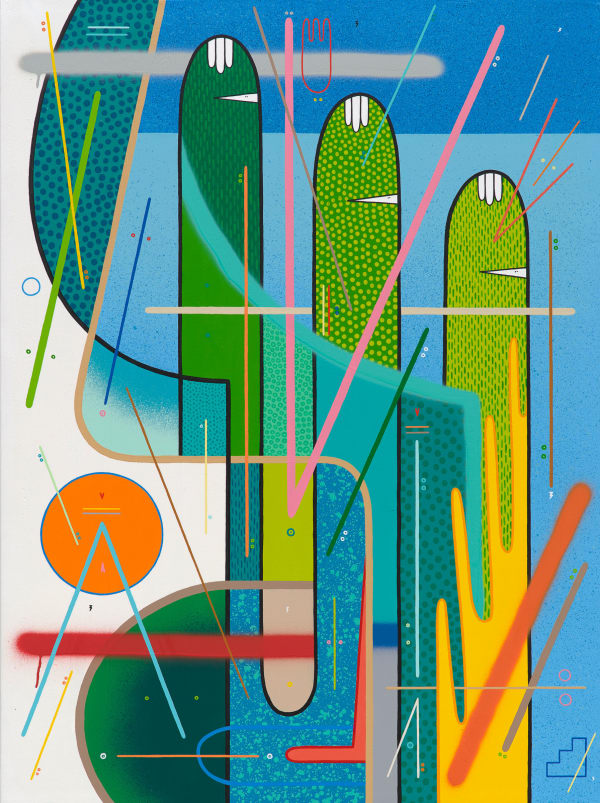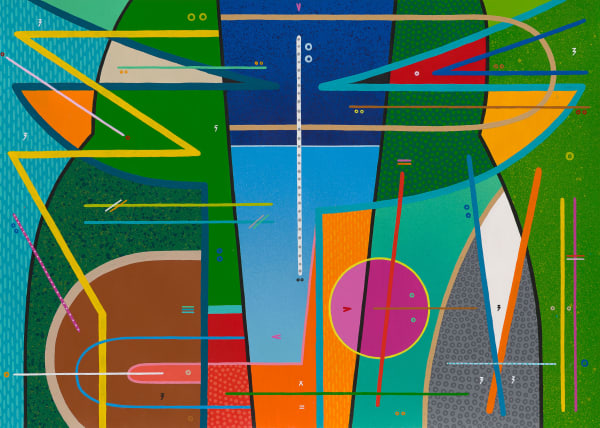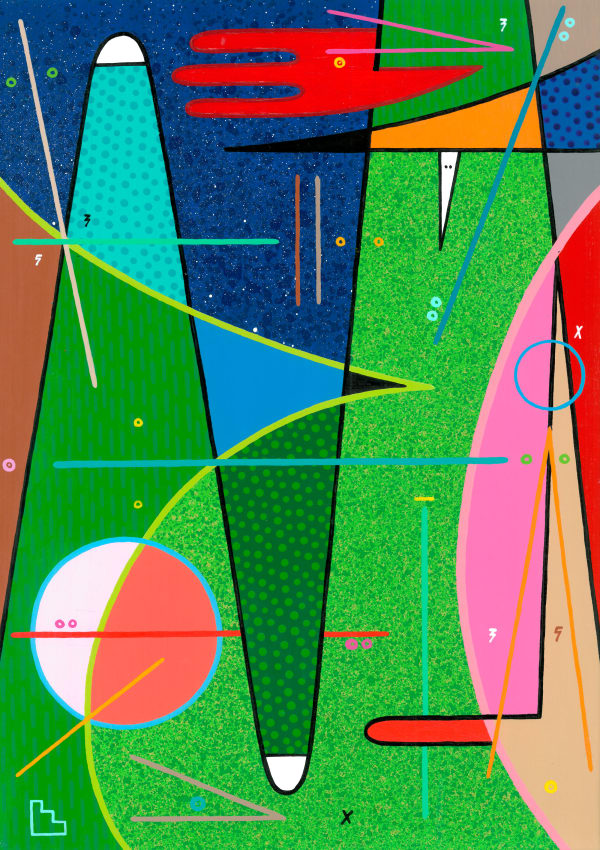Naturaleza Continua: Sixe Paredes | Delimbo Sevilla
The sphere of what we are capable of imagining
«The dream follows the mouth that interprets it.»
Berajot 55b. See Georges Levitte and Guy Casaril, «Les rêves et leurs interprétations dans les textes post-bibliques», in Évidences, Nº 82 (March 1960), pp. 18-28.
I met Sergio Hidalgo, Sixe Paredes, at the beginning of the golden nineties. As it occurred to almost all of us, when we left school we went painting in the streets. We didn’t really have any expectations for the future, but from him I learned that without having to be a virtuoso you can be a great self-taught painter. His art was then introduced in Spain; and he began to cultivate his own worldview. Soon it began to be anointed with all the brutality that it still holds today. From this endeavour and within his workshop he prepared the vastness of his work, giving it the same playful misuse that he had come across when evaluating everything that passed through his hands. His peculiar method, juicy and ironic, was the true tiny discourse on the destruction or nonsense that he witnessed here (west) and there (east).
Sixe Paredes wants to find the conjunction between the primitive and the eternal within being. This is displayed in his easy handling and immediate use of plastering his canvases with prepared colour pastes, suggestive of abandoned and forgotten walls. For this, he enforces the very important role that mural painting played as a link between the East and the West. Regarding the sinopia of the primal world, to the line made up of elements alternating with the same use as that of the strokes, but to distinguish the indications represented. Imaginary line: time line or solar quadrant, achieved by combinations, the result of the gradation of ink and color, mandated by the composition, arrangement or the rhythm where the eye tends to cut or carve.
Reduction of the number of colours in opposition to monochrome, when it is possible to recover the primitive sculpture that is always polychrome. To turn painting into the upholstery, as this is how eastern art always expresses its penchant for bright colors and rare materials. It is necessary to observe how it produces surprise, the unexpected discharge of a psychological device on which an entire art rests. Paintings, sculpture, ceramics, weaving, wallpapers, roll-uped and portable, that all have a deep self-awareness akin to the mystery of crop circles (the true reality of the world). It even acquires a greater coherence with the avant-garde movement to which he belongs. It renews and reinforces itself because it teaches us that his work is a modern concept of progress.
Of course, we could furnish many examples as well. The aforementioned is enough to have a precise image of the importance of the essential role of Sixe Paredes. It is, undoubtedly, the testimony of a creative adventure of extraordinary relevance in contemporary Hispanic art. His art has traveled the world, and as if that were not enough, he has come to exhibit in and paint the facade of the National Museum of Modern Art in London (Tate Modern). Indeed, the curious public will perhaps recognise the cited references. The best advice in painting is the one that is not given. There is no need to insist. There is a kind of logical divorce between theory and experience that baffles even the artists themselves who have been its agents and promoters.
Following this biographical tour I will focus on other aspects. What I have tried on this occasion is to make known a Sixe Paredes free of all the apparatus of notes that usually accompanies him: to experience within the imagination. What in a way we already knew from Pierre Reverdy: «The image is a pure creation of the mind. It cannot be born of a comparison, but only of the bringing together of two or more less distant realities.». Sixe strives to explore the ins and outs of memory and forgetting. And to bring to light the tensions that still exist today between those who refuse to remember and those who insist on it. He has always been a bridge builder, where he has preferred to go back over the past from the point of view of a more neutral narrator. Sixe’s work is entirely devoted to the investigation of a true enunciation, in conformity with the things themselves. This search for an involuntary memory is the product of polysensoryity. They say that the evening light sets the scene forever. Sixe Paredes, tireless and persevering explorer of the semiotic forms engendered by sensory associations. Here he proposes an example of two canonical figures that we must explore: On the one hand; the envelope of painting where sensations are closely and durably interwoven with the brilliance, freshness and vitality of the living thing. On the other; movement, something similar to a number line, to which a conjugation of original sensations is linked through all subsequent, analogous movements, which will revive the impressions and associated experiences. Sixe presents a character of sufficient canonicity to outline the experience and contribute in an emblematic and even direct way to the memory process.
It is not, therefore, only a question of memory, but also of modes of presence. The interest in keeping such protected things alive. A trait that must be related to the moment of recall: the living thing speaks, it has something to say to those who witness its appearance. In this way, the thing is an art that rejects virtuosity and grace at all times. It is a critic that always comes later. Matter ends, memory ends. That is the bridge and everything that follows has to be collected under a single title. Sixe has placed in my hands a material that had been jealously guarded. See, receive and hear. Rare natural stories, true relationships that almost no one wanted to hear. Sixe Paredes is that moment of the game in which you know you’ve won and try to appear indifferent, and look towards the sea… with that blind and obsessive glare. Baudelaire’s phrase in Les Fleurs du mal is thus affirmed: “I am the wound and the dagger! I am the blow and the cheek!”
Creation of stillness? We commit a terrible mistake when in our thesis we do not show our personal experience for what it is, something subjective, but we imply our conviction as the measuring stick of what is the truth and what is not. A concrete state of mind is never to depend on anything. Sixe aspires, then, to escape from that fossilisation typical of the art markets. Hence, the natural takes a back seat, to be hidden or diluted. What ravaged kingdom do they offer us? The art that teaches the afterlife? If Romanesque art was an art without windows, without lights; That which was not seen and was said to master the people. Well, I think that the people had already mastered it, and lost in a circular landscape, sacred art ends when the entire journey that exists after death is questioned. For this reason, it is important to insist on the great ingenuity with which Sixe circumvents the difficulties of the art world and on the prodigious range of metaprogramming effects with which he enriches his artistic life. It is the thudding contrary to the one-night traveler, insistent like a heartbeat, like nocturnal butterflies that hit the windowpane; an annoying and inescapable call to work. Subjected to the pressures of the environment, Sixe is also critical and even satirical within the gears of ecology, without falling into the culturalism of human nature where they say that a dead fish indicates the limits. There is a continuous effort. In fact he does not defend the revolution, but the evolution. Sixe Paredes is praised as an artist of the proletariat and the revolution. He is pushed more strongly towards that role when he declares that he does not belong to any party. That is why he does not dare to stop representing it. He has already been a revolutionary. So he won’t draw the same thing again. It is not a burning desire, but a commandment, a demand.
The brave sleep alone.
Barcelona, September 24, 2021


















